House price rises continue in Canada

Despite government attempts to tame the housing market, house prices in Canada’s eleven major cities rose by 5.35% (3.26% inflation-adjusted) during the year to end-Q3 2014.
This represents a rising trend. Annual house price growth was 4.45% (2.04% inflation-adjusted) in Q2 2014, and 4.64% (3.04% inflation-adjusted) in Q1 2014, according to Teranet – National Bank of Canada.
During the latest quarter (Q3 2014), nationwide house prices rose by 2.23% (2.31% inflation-adjusted).
Calgary had the highest y-o-y house price increase at around 9.17% during the year to November 2014, followed by Toronto (7.25%), Hamilton (7.05%), Edmonton (6.18%), and Vancouver (5.93%).
Winnipeg (1.51%), Victoria (1.45%), and Montreal had smaller price hikes.
There were house price declines in Ottawa (-0.22%), Québec (-0.28%), and Halifax (-1.76%).
According to the Canadian Real Estate Association (CREA):
- The national average price of one-storey single family homes rose by 4.51% during the year to December 2014.
- The average price of two-storey single family homes increased by 6.98% y-o-y to December 2014.
- Townhouses / row units had an average house price increase of 5.31% over the same period.
- As compared to other property types, apartments had a price increase of 3.51% y-o-y to December 2014.
The national average price for homes sold rose to CA$ 474,600 (US$ 395,962) in December 2014 from a year ago, according to CREA.
The history of a moderate boom
House prices in Canada rose by 49% from Q1 2000 to Q1 2009, due to low interest rates and economic growth.
From Q2 2009 to Q4 2012, house prices increased by another 17%, despite government efforts to cool the housing market.
Canada’s house prices are projected to increase by another 0.7% in 2015, according to CREA. Average house prices are expected to rise by 2% in Alberta and Manitoba; Ontario has a 1.3% predicted price gain. Other provinces are expected to have stable average prices, with around less than one percentage point increase.
In contrast the realtor Royal LePage says the price of a Canadian home is expected to rise by 2.9% on average in 2015, with Toronto expected to lead the pack with average home prices forecast to rise by 4.5%. Vancouver is expected to see the second-biggest average jump in prices, up 2.8%, followed by a 2.4% gain in Calgary, and 0.6% in Montreal.
More cooling measures expected in 2015
The booming housing market has been a major concern for the government. To ensure a soft landing, tighter mortgage rules took effect on July 9, 2012:
- The reduction of maximum amortization from 30 years to 25 years, discouraging buyers from acquiring too much debt; and
- The maximum LTV ratio was lowered from 85% to 80%.
The government will also:
- Limit the maximum gross debt service (GDS) to 39%, and the total debt service (TDS) to 44%; and
- Ban mortgage insurance on properties over $1 million.
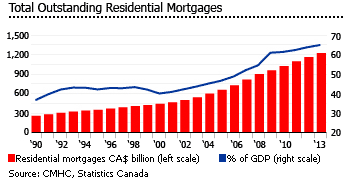
The Canada Mortgage and Housing Corporation (CMHC) has limited its guarantees to banks and other lending companies in mid-2013, in a bid to slow the housing market. During early 2014, the CMHC discontinued mortgage insurance for condominium construction, and ceased providing mortgage insurance to second home buyers or to self-employed borrowers without third-party income validation.
The government may implement further market-cooling measures, warned Joe Oliver, Canada’s Finance Minister, at end-2014. “Our main goal is reducing the government’s exposure to the mortgage market,” said Oliver.
Mortgage interest rates at new historic low
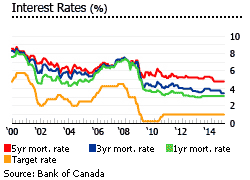
On January 22, 2015, amidst expectations of retaining or raising Canada’s key interest rate this year, the central bank shocked markets with an unexpected rate cut by 0.25 percentage point to 0.75%. The rate cut was due to an anticipation of lower inflation brought by the oil price collapse.
The Bank of Canada had previously maintained its key interest rate at 1% for 14 policy announcements, since September 2010. According to the Bank of Canada’s statement last December 2014, the economy showed signs of “broadening recovery”. However, the bank also pointed out potential threats such as weakening oil prices driving down inflation, as well as risks of high household debt.
The OECD had predicted that the Bank of Canada would start raising its key interest rate in late May 2015.
However “The oil price shock increases both downside risks to the inflation profile and financial stability risks,” said a statement from the Bank of Canada. Moreover, the bank stated that the rate cut provided insurance against risks, and supported the adjustment the economy needs to return to full output.
Even before the shock announcement, Canadian mortgage rates were at historic lows, compared to pre-crisis levels of 2008:
- The 1-year mortgage rate was at 3.14% in December 2014, down from 5.6% in December 2008.
- Interest rates on 3-year mortgages were at 3.44% in December 2014, down from 6.25% in December 2008.
- The 5-year mortgage rate was at 4.79% in December 2014, down from 6.75% six years earlier.
Home sales up
The year 2014 saw the most homes traded for seven years. Around 481,162 homes changed hands through the MLS® Systems. Sales were 5.1% up.
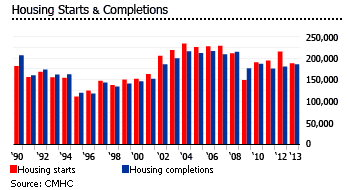
In December home sales fell 5.8% from the previous month, but remained above year-ago levels, according to the Canadian Real Estate Association (CREA). The decline was mainly due to a 25% drop in Calgary and Edmonton.
“December sales were down from the previous month in a number of Canada’s largest and most active housing markets, indicating a broadly based cooling off for Canadian home sales as 2014 came to an end,” according to CREA’s Chief Economist Gregory Klump.
Yet sales were higher than year-ago levels in around 2/3 of the total local markets, especially in Greater Vancouver and the Fraser Valley, the Greater Toronto Area, and Montreal, according to CREA.
Housing starts fell by 12.5% in 2013 to 187,923 units, according to the Canada Mortgage and Housing Corporation (CMHC). Housing completions rose by 3% to 185,494 units in 2013, but was still 10.5% below the average number of housing units completed from 2002 to 2008.
Used home prices rising faster than new house prices
The new housing price index (NHPI) in Canada rose by 1.7% during the year to November 2014, led Calgary (6.5%) and the combined metropolitan region of Toronto and Oshawa (2.5%), according to Statistics Canada. 7 out of 21 metropolitan areas surveyed posted y-o-y price drops in November, led by Charlottetown (-1.9%), Victoria (-1.1%), and Ottawa–Gatineau (-1.0%). Regina had its first annual price decline since 1985, by about 0.2% in November 2014. Similarly, Montreal also had its first y-o-y price drop since 1997, at around 0.1% during the same period.
Stable rental market; lower vacancy rate
Average rents in Canada rose by 2.3% during the year to April 2014, according to CMHC. Rents for new and existing two-bedroom apartments rose in all provinces except Prince Edward Island, which slightly fell by 0.6%. Alberta had the highest rent increase, rising by 6.5% during the period. It was followed by Saskatchewan with a 6% rise in rent.
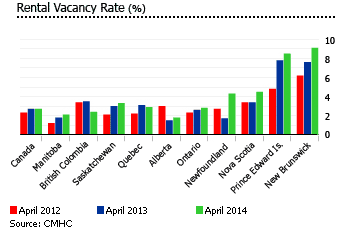
Gross rental yields in Montreal are moderate to high, ranging from 4.67% to 6.09% as of January 2014, according to the Global Property Guide research (the "rental yield" is the annual percentage return that an owner can earn renting out his property). There was a noticeable decline in the average rental yield in Montreal, to 5.57% in 2014, as compared to the 7.19% average in 2012.
In Toronto, rental yields range from 4.66% to 5.19%. The average rental yield slightly rose to 4.92%, from an average of 4.70% in 2012.
The most expensive rental properties are in Alberta, which has an average monthly rent of CA$ 1,190 (US$ 993) for a two-bedroom apartment. It is followed by British Columbia with an average monthly rent of CA$ 1,090 (US$ 909), Ontario with CA$ 1,072 (US$ 894) per month, and Saskatchewan with CA$ 1,036 (US$ 864) per month.
Quebec has the lowest two-bedroom apartment rents at CA$ 709 (US$ 592).
The national vacancy rate remains stable at 2.7%, same as the previous year, according to the CMHC. Bruno Duhamel, CMHC’s Manager of Economic and Housing Analysis. “Demand for rental housing continues to be supported by population gains from net migration and stable employment levels for young workers aged 20 to 24,” Duhamel explained.
New Brunswick has the highest vacancy rate (9.1%), followed by Prince Edward Island (8.5%), and Nova Scotia (4.5%). Alberta has the lowest vacancy rate (1.8%).
Strong economic growth expected in 2015
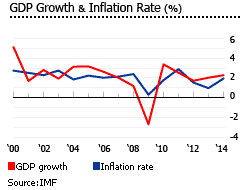
Canada’s economy grew faster than expected during the third quarter of 2014, posting a 2.8% annualized real GDP growth, according to Statistics Canada. The economy´s expected 2.3% expansion in 2014 was an improvement from 2% growth in 2013, and 1.7% in 2012.
The country’s economic growth is expected to be close to 2.5% in 2015, according to the Bank of Canada (BoC), but is expected to slow to 2% by end-2016. However, BoC’s economic growth forecast for 2015 was trimmed down to 2.1% recently, due to the plunging oil prices that are expected to bring negative impact on the economy.
Unemployment was 6.6% in December 2014, according to Statistics Canada, down on last year’s 7.2%. In 2014 the country created around 185,700 new jobs, mostly in the second half. From 2009 to 2013, the average unemployment rate rose to 7.6%, up from 6.9% from 2000 to 2008, according to the International Monetary Fund (IMF).
Inflation slowed to 2% during the year to November 2014. In 2013, inflation was at almost 1%, according to the IMF. In 2015, inflation is expected to be around 2%, based on IMF figures.